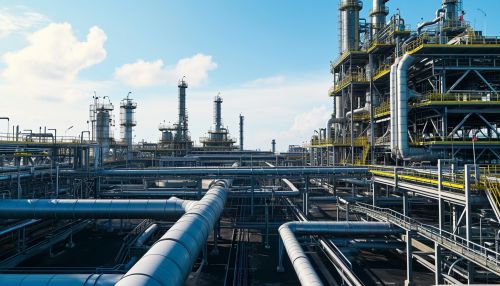Hydrogen Gas
Introduction
Hydrogen is the lightest and most abundant chemical element in the universe, constituting roughly 75% of its elemental mass. It is the primary building block of the universe, with its nucleus (a single proton) present in all but a few of the universe's isotopes. Hydrogen gas (H2) is the molecular form of hydrogen, consisting of two hydrogen atoms bonded together.
Properties
Hydrogen gas is colorless, odorless, tasteless, and highly flammable. It is lighter than air, allowing it to rise in the atmosphere. It has a molecular weight of approximately 2.016 grams per mole, and its density at standard temperature and pressure (STP) is around 0.08988 grams per liter. It has a boiling point of -252.87 degrees Celsius and a melting point of -259.16 degrees Celsius.
Production
Hydrogen gas can be produced through various methods, including Steam Methane Reforming (SMR), Electrolysis, and thermochemical cycles. SMR is the most common method, where methane reacts with steam under 3–25 bar pressure in the presence of a catalyst to produce hydrogen, carbon monoxide, and a small amount of carbon dioxide. Electrolysis involves the decomposition of water into oxygen and hydrogen gas due to an electric current being passed through the water. Thermochemical cycles involve a series of chemical reactions that produce hydrogen.


Uses
Hydrogen gas has a wide range of applications. It is used in the Haber process for the production of ammonia, a key component of many fertilizers. It is also used in the hydrogenation of fats and oils, in methanol production, in hydrocracking, and in hydrodesulfurization. Hydrogen is also used as a rocket fuel, where it provides a high specific impulse. In recent years, there has been an increased interest in using hydrogen gas as a source of clean energy in fuel cells.
Safety and Precautions
Due to its high flammability and ability to form explosive mixtures with air, handling hydrogen gas requires caution. It is important to ensure that hydrogen gas is stored away from heat sources and open flames. It should also be stored in approved containers and the area should be well ventilated. In case of a hydrogen leak, it is crucial to avoid sparks or flames as they can ignite the gas.
Environmental Impact and Sustainability
Hydrogen gas, when used as a fuel, produces water as a byproduct, making it a clean source of energy. However, the production of hydrogen gas, especially through methods like SMR, can result in greenhouse gas emissions. Therefore, the environmental impact of hydrogen gas largely depends on how it is produced. The use of renewable energy sources for hydrogen production, such as in electrolysis powered by wind or solar energy, can make hydrogen a truly sustainable energy carrier.
Future Prospects
The future of hydrogen gas looks promising, especially in the context of clean energy. With advancements in hydrogen production technologies and the push for greener energy sources, hydrogen gas could play a significant role in the energy landscape of the future. Hydrogen fuel cells, for instance, are being explored for use in vehicles, and hydrogen is also being considered for large-scale energy storage.
